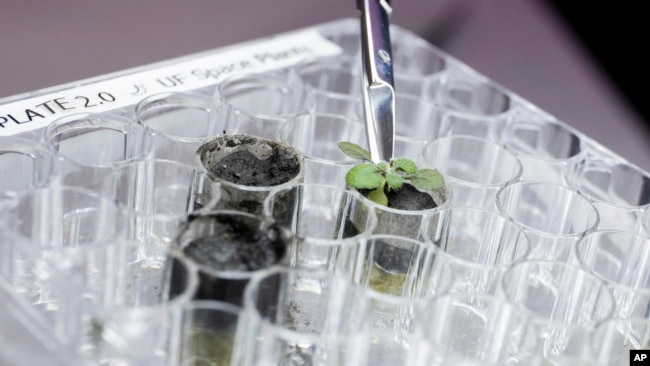月の土で植物栽培成功
人類が初めて月に降り立ったのは、1969年7月20日。53年前の事。
驚くべきニュースですが、どうしてもっと早く実験しなかったのかなぁ?
VOAで今日も楽しく英語を学びましょう!!
月面の土で植物を育てる科学者たち(和訳)
Scientists Grow Plants in Dirt from Moon
May 17,2022
NASAのアポロ宇宙飛行士が採取した月の土で、科学者たちが初めて植物を育てました。
科学者たちは、月の土で何かが育つのかどうか、見当もつきませんでした。彼らは、次世代の月探査機による食料の栽培に利用できるかどうかを確かめたかったのです。その結果は、科学者たちを驚かせました。
フロリダ大学食品農業科学研究所のロバート・フェル氏は、その結果に驚きました。「植物は実際に月のもので育つのです。冗談でしょう?」
フェル氏と他の研究者は、アポロ計画から戻ってきた月の土に、小さな花を咲かせる植物、セイル・クレスを植えました。良い知らせは、すべての種が成長したことです。
悪い知らせは、最初の1週間は、月の土が植物にストレスを与えてしまい、成長が遅くなってしまったことでした。ほとんどの月見草は発育不良–つまり、小さかったり、十分に育っていなかったりしたのです。
この研究結果は、最近出版されたCommunications Biology誌に掲載されました。
月の土壌が放射線や太陽風にさらされる時間が長ければ長いほど、植物の状態は悪くなるようです。アポロ11号のミッションで採取された土壌は、生育に最も役立リませんでした。科学者たちは、この土壌は数十億年長い間、様々な要素にさらされていた、と語っています。
ウィスコンシン大学マディソン校のサイモン・ギルロイ氏はこの研究に加わっていません。彼は、「これは植物を育てることができるということを知るための大きな一歩です。」と言います。ギルロイ氏は、さらに「本当の次のステップは、月の表面でそれを行うことです。」と付け加えました。
月の土は、微小隕石の衝突によるガラス粒子でいっぱいです。この粒子がアポロの月着陸船に入り込み、月面歩行者の宇宙服を摩耗させました。
溶岩流のような月の若い地質学的スポットを利用して土を掘り起こすのも1つの解決策かもしれません。また、特殊な栄養剤を加えたり、人工照明を当てたりして環境を変えることも考えられます。
月に降り立った6人のアポロクルーが持ち帰った月の石や土は、わずか382キログラムに過ぎません。そのため、研究者は地球上の火山灰でできた土で実験することを余儀なくされています。
昨年初め、NASAはついにフロリダ大学の研究者に12グラムの土を配り、植え付け実験に使いました。NASAは、数年後に宇宙飛行士を月に戻したいと考えており、このような実験を行うタイミングがやっと訪れたと言っています。
将来の宇宙飛行士にとっての最良の状況は、水耕栽培、つまり水だけのシステムを立ち上げる代わりに、現地の土を室内植栽に使うのがだろうと科学者は話します。
シャミラ・バッタチャリヤ氏は、NASAの宇宙生物学プログラム・サイエンティストです。バッタチャリヤ氏は、最適化という言葉を使ってこれからの仕事を表現します-つまり出来るだけ良くて効果的なという意味です。
「何かが成長したという事実は、私たちが本当に良い出発点を得たということであり、あとはどのように最適化し、改善していくかということです。」と彼女は話します。
フロリダの科学者たちは、今年後半に月の土を再利用し、さらにセイヨウノコギリソウを植えてから、他の植物に移行することを希望しています。
Scientists Grow Plants in Dirt from Moon
For the first time, scientists have grown plants in moon soil collected by NASA’s Apollo astronauts.
The scientists had no idea if anything would grow in the moon dirt. They wanted to see if it could be used to grow food by the next generation of moon explorers. The results surprised them.
Robert Ferl of the University of Florida’s Institute of Food and Agricultural Sciences was surprised with the results. “Plants actually grow in lunar stuff. Are you kidding me?” he said.
Ferl and other researchers planted thale cress, a small flowering plant, in moon soil returned from the Apollo missions. The good news was that all of the seeds grew.
The bad news was that after the first week, the lunar soil stressed the plants so much that they grew slowly. Most of the moon plants ended up stunted – meaning small or not fully developed.
Results of the study appeared recently in the publication Communications Biology.
The longer the soil was exposed to radiation and solar wind on the moon, the worse the plants seemed to do. The soil collected by the Apollo 11 mission was the least helpful for growth. It was exposed a couple billion years longer to the elements, the scientists said.
Simon Gilroy of the University of Wisconsin-Madison was not part of the study. He said, “This is a big step forward to know that you can grow plants.” Gilroy added, “The real next step is to go and do it on the surface of the moon.”
Moon dirt is full of glass particles from micrometeorite impacts. These particles got in the Apollo lunar landers and wore down the moonwalkers’ spacesuits.
One solution might be to use younger geologic spots on the moon, like lava flows, for digging up soil. The environment also could be changed by adding special nutrient mixtures or artificial lighting.
Only 382 kilograms of moon rocks and soil were brought back by the six Apollo crews that landed on the moon. Most of them are still locked away, forcing researchers to experiment with soil made of volcanic ash on Earth.
Early last year, NASA finally gave out 12 grams of soil to the University of Florida researchers for the planting experiment. NASA said the timing for such an experiment was finally right, with the space agency looking to put astronauts back on the moon in a few years.
The best situation would be for future astronauts to use local dirt for indoor planting instead of setting up a hydroponic, or all-water, system, scientists said.
Sharmila Bhattacharya is NASA’s program scientist for space biology. Bhattacharya used the term optimize – meaning to make something as good or as effective as possible – to describe the work that lies ahead.
She said, “The fact that anything grew means that we have a really good starting point, and now the question is how do we optimize and improve.”
The Florida scientists hope to reuse their lunar soil later this year, planting more thale cress before possibly moving on to other plants.
Words in This Story
lunar – adj. of or relating to the moon
kid – v. to speak to (someone) in a way that is not serious : to say things that are not true to (someone) in a joking way
micrometeorite -- n. a meteorite so small that it can pass through the earth's atmosphere without becoming intensely heated; a very small particle in interplanetary space
